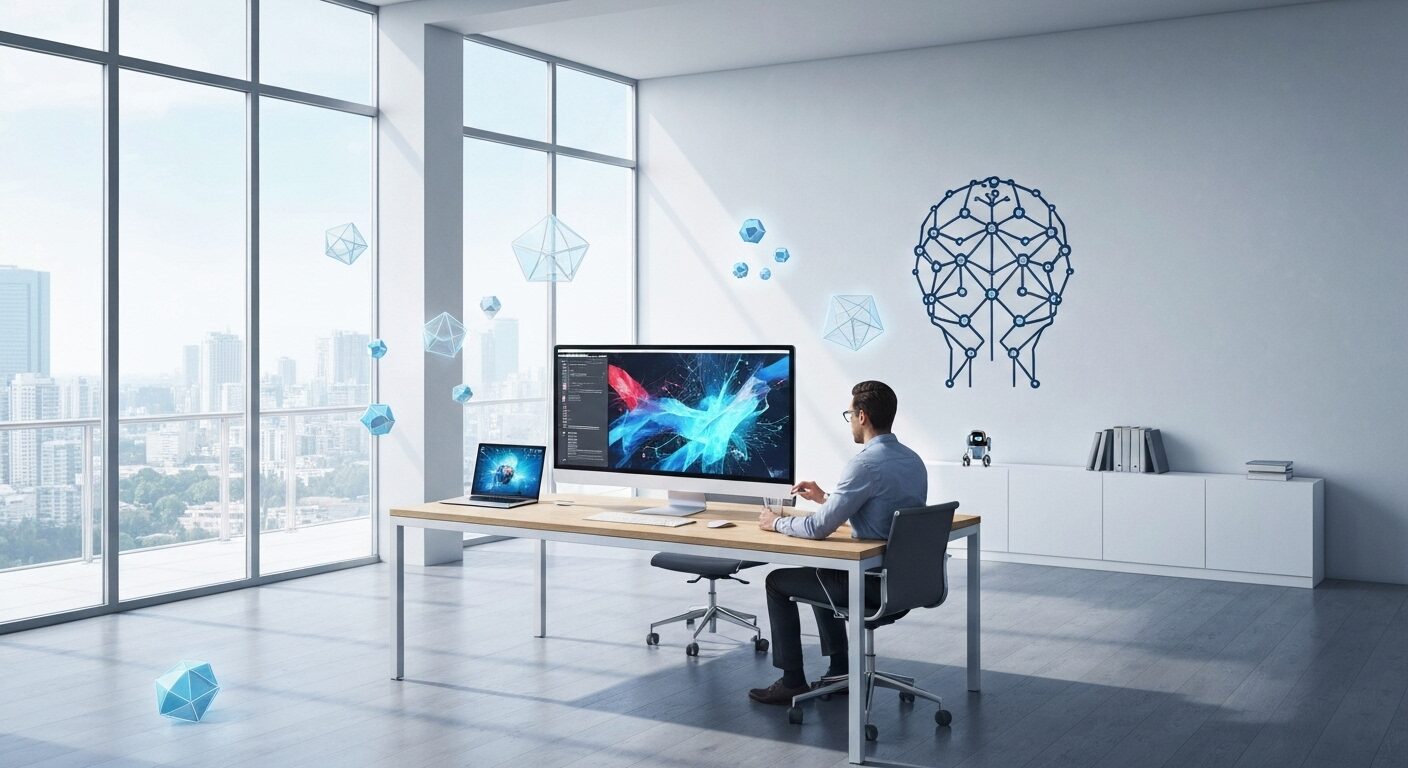AMD’s destiny now hinges on its consolidation in the lucrative Artificial Intelligence market, challenging giants and redefining its value for the most demanding investors.
Advanced Micro Devices (AMD) stands at a decisive inflection point, where its fate is no longer shaped solely by its traditional CPU and GPU segments for PCs and gaming, but rather by its ability to establish itself as a dominant force in the fast-paced and profitable Artificial Intelligence (AI) market. This article dives deep into the company’s recent trajectory, analyzing the impact of AI on its market valuation, its product and software strategy to challenge the hegemonic Nvidia, and the transformative significance of its partnership with OpenAI.
I. AMD’s New Reality: Finances Under the AI Lens
The stock market, an unforgiving barometer of future expectations, has recalibrated its valuation of AMD, now almost exclusively through the lens of Artificial Intelligence potential. The days when PC or gaming console performance dictated investor sentiment seem distant, eclipsed by the promise of exponential growth in AI.
Market Volatility and Exponential Expectations
AMD shares have recorded significant appreciation, with year-to-date gains exceeding 70%, propelling the company to new highs. However, this rapid ascent is accompanied by notable volatility, exposing a fundamental shift in investor perception. A striking example of this new dynamic occurred after the release of the second quarter of 2025 results. Despite revenue exceeding projections, shares fell more than 6% in after-hours trading.
This seemingly counterintuitive reaction was a direct reflection of investors’ extreme sensitivity to AI growth numbers. The slowdown in the Data Center segment, even while robust, was interpreted as a sign that AMD was not meeting the expectations of a market that prices in perfection and continuous, exponential growth. AMD Brazil’s General Manager, Sérgio Santos, acknowledged that the “buzz and the huge noise around AI” created expectations that sometimes even surpass the company’s internal targets. This is the new landscape for tech companies, where the perception of AI potential can be worth more than traditional performance.
Recent Financial Performance: Strength in Core Businesses, Challenges in AI
A detailed analysis of AMD’s first and second quarter 2025 results reveals a picture of duality. The company showed solid performance in its core businesses but faced external pressures and intense scrutiny over its most critical segment: Artificial Intelligence.
In the first quarter of 2025, AMD delivered exceptional performance, with revenue of $7.4 billion, a 36% year-over-year increase, primarily driven by the Data Center segment, which grew an impressive 57%. However, the second quarter brought a shift. Record revenue of $7.7 billion (a 32% YoY increase) was overshadowed by a slowdown in Data Center growth, which registered only 14% YoY. The company attributed this slowdown directly to the impacts of US government export restrictions to China, affecting the MI308 GPU.
This geopolitical scenario not only impacted revenue but also compressed the non-GAAP gross margin, which fell to 43% due to an inventory write-down of approximately $800 million. Excluding this one-time event, the gross margin would have been a healthier 54%. In contrast, the combined Client and Gaming segment demonstrated notable strength, with revenue of $3.6 billion (a 69% YoY increase), driven by strong demand for Ryzen processors.
| Metric | Q1 2025 | Q2 2025 | YoY Change (for Q2) |
|---|---|---|---|
| Total Revenue ($B) | $7.44 | $7.69 | +32% |
| Data Center Revenue ($B) | $3.70 | $3.20 | +14% |
| Client and Gaming Revenue ($B) | $2.90 | $3.60 | +69% |
| Embedded Revenue ($B) | $0.82 | $0.82 | -4% |
| Gross Margin (%) | 54% | 43% (54% ex-charges) | -10 p.p. |
| Operating Income ($B) | $1.78 | $0.90 | -29% |
| Diluted Earnings Per Share ($) | $0.96 | $0.48 | -30% |
Source: AMD press releases.
Looking Ahead: Confidence and the MI350 Accelerators
Despite the turbulence, AMD projects a strong recovery. For the third quarter of 2025, the company anticipates revenue of approximately $8.7 billion, a 28% YoY growth, with the gross margin returning to 54%. This projection is intrinsically linked to the successful execution of the launch of the MI350 accelerator series in the second half of 2025. It is a “seeing is believing” moment, where demand for these new products from customers outside of China must be robust enough to drive this significant growth and validate AMD’s AI strategy.
II. AMD’s Hardware and Software Strategy in the Fight Against Nvidia
AMD’s competitive strategy in the AI market is a calculated move to attack Nvidia’s main bottleneck—memory—while working intensely to close the software gap with its ROCm platform.
Instinct GPUs: Memory as a Competitive Advantage
The roadmap for AMD’s AI accelerators, such as the Instinct series, demonstrates a deliberate focus on superior memory capacity and bandwidth. This architectural design aims to exploit a strategic vulnerability in competitors’ products, especially for large language models (LLMs) with trillions of parameters.
- MI300X: Launched in late 2023, it boasts 192 GB of HBM3 memory, more than double the Nvidia H100 at the time. This capacity allows LLMs like Llama 2 70B to fit entirely on a single accelerator, eliminating model-splitting latency.
- MI325X: Launched in October 2024, it raises capacity to 256 GB of HBM3E with 6.0 TB/s of bandwidth, surpassing the Nvidia H200 in both capacity and bandwidth.
- MI350 Series (CDNA 4): Expected in the second half of 2025, it promises up to 288 GB of HBM3E and 8.0 TB/s, maintaining a significant lead over the Nvidia B200.
This is an “asymmetric war,” where AMD does not seek universal superiority but rather optimization for memory-intensive generative AI workloads, where its architecture offers a clear advantage in cost and performance for large-scale LLM inference and training.
ROCm: Building an Open Ecosystem Against the CUDA Wall
In the AI landscape, hardware is only part of the equation; software is equally crucial. Nvidia’s CUDA platform is a powerful competitive “moat,” with over a decade of development. AMD’s challenge is to make its open-source software, ROCm (Radeon Open Compute), a viable, low-friction alternative.
Historically, software has been AMD’s weak point. However, significant advancements have been made. ROCm 6 has already demonstrated maturity for AI workloads with the MI300X, and ROCm 7 promises massive performance gains (up to 3.5x in inference) and full support for the MI350 series, including low-precision data types and distributed inference frameworks. An important validation came from Google Gemini, which integrated AMD GPU support into Triton, its open-source compiler, a sign of growing acceptance in the community.
AMD’s “open ecosystem” strategy for ROCm is both a necessity and a choice. The company cannot match Nvidia’s software development resources alone. By opening up ROCm, AMD invites the community—ranging from hyperscalers to individual developers—to contribute. The partnership with OpenAI is the ultimate example of this strategy, where such an influential customer contributes its expertise to optimize ROCm, acting as a force multiplier. This is a battle between the “Open Ecosystem” and Nvidia’s “Walled Garden,” and AMD is betting on flexibility and customization. For more on the impact of AI across various spheres, check out this article on How the Netscape vs. Microsoft War Defines the Future of OpenAI.
III. The Transformative Agreement with OpenAI and the Competitive Landscape
AMD’s strategic partnership with OpenAI is not just a large sales order but a transformative event that validates AMD’s technology, aligns incentives for software development, and fundamentally alters the competitive dynamics of the AI hardware market.
The Strategic Weight of the OpenAI Partnership
AMD and OpenAI have entered into a multi-year agreement for the supply of up to 6 gigawatts (GW) of AI compute capacity, with the first phase commencing in the second half of 2026, utilizing the future MI450 series. To put this in perspective, 6 GW is the energy required to power about 5 million US homes. This is a colossal infrastructure project, solidifying AMD as a primary and strategic supplier to the world’s leading AI research lab, with projections to generate “tens of billions of dollars” in annual revenue for AMD.
This deal is a testament to the AI industry’s desperate need for supply diversification. The demand for AI compute is insatiable, and even Nvidia’s capacity cannot meet the entire market. By establishing a second source of critical hardware, OpenAI mitigates risk, reduces its dependency on Nvidia, and gains negotiation leverage. Barclays analysts noted that the deal is “proof that the ecosystem is desperate for more compute,” elevating AMD’s perception from a niche player to a strategic enabler. OpenAI’s influence and its applications also extend to unexpected areas, as seen in ChatGPT Becomes Shopping: How OpenAI is Changing Your Online Purchases.
The Warrant Mandate: A Genius Move
One of the most innovative aspects of the agreement is the issuance of a warrant allowing OpenAI to purchase up to 160 million AMD shares (about 10% of the company) at a nominal price, conditional on deployment milestones and stock price targets, with the final tranche tied to $600 per share.
This structure, described as “clever” even by Nvidia CEO Jensen Huang, transforms the customer-supplier relationship into a deeply invested partnership. The warrant incentivizes OpenAI to actively contribute to the success of AMD’s platform, especially in ROCm software, to maximize the value of its equity stake. By granting a potential 10% stake, AMD is effectively “paying” for OpenAI’s world-class software engineering expertise. It is a “Trojan Horse strategy” to penetrate the CUDA moat, using its most important customer to help build the software ecosystem that will attract other customers.
Challenges and Opportunities in Nvidia’s Domain
Nvidia’s dominance in the AI GPU market is overwhelming, controlling over 80% of the training market. The key to this hegemony lies not only in its hardware but in its CUDA software platform, which is deeply integrated into major AI frameworks, creating significant switching costs. Competing with Nvidia requires building a viable alternative for the entire CUDA ecosystem, not just a faster chip. Developer inertia in migrating is Nvidia’s greatest competitive advantage.
However, the AI market is shifting. In the long term, the largest segment will be inference (model execution), where cost and power efficiency are more critical than raw peak performance. This shift favors AMD’s strengths. Its memory-rich architecture is ideal for running large models efficiently, and the MI350 series promises a 35-fold leap in inference performance. AMD can position itself as the “value” and “efficiency” choice for this growing segment. To succeed, AMD doesn’t need to dethrone Nvidia, but rather capture 15% to 25% of a rapidly expanding AI accelerator market—a much more plausible goal following the OpenAI deal. For broader reflection on AI’s impact, reading about AI and the Cosmos: Is Humanity the Stepping Stone for Universal Conquest? or the Hidden Side of AI is worthwhile.
Future Outlook and Projections: Risks and Key Indicators
The optimistic scenario for AMD envisions a path to over $100 billion in AI revenue, driven by a validated and competitive product roadmap, the transformative momentum of the OpenAI partnership, and a massive expanding market with room for a strong number 2. If AMD executes its strategy successfully, it is plausible that it could capture between 15% and 25% of the AI accelerator market by the end of the decade.
The risks, however, are substantial. Product roadmap delays or failure to meet performance targets would be severely punished. The ROCm software gap, despite progress, remains a major challenge; if developers find it difficult to use or lacking in critical features, hardware advantages will be nullified. Nvidia will not stand still, defending its dominance with fierce competitiveness in performance, price, and ecosystem. Geopolitical factors, such as export controls, can also materially impact revenue.
To track AMD’s progress, investors should monitor the growth and mix of Data Center revenue, especially the acceleration of the Instinct GPUs portion. Announcements from other major customers and the evolution of ROCm adoption are crucial, as is the trajectory of gross margin and third-party competitive benchmarks comparing AMD’s products with Nvidia’s. The AI revolution also brings developments on other fronts, such as the new functionalities of Google Gemini, showing the vastness of the current technological impact.
AMD has successfully transitioned from a CPU-focused company to a credible challenger in the high-stakes AI accelerator market. The combination of a strategically differentiated hardware roadmap and the transformative validation of the OpenAI partnership has fundamentally altered its long-term prospects. However, the road ahead is fraught with challenges, demanding near-perfect execution. While it is unlikely AMD will dethrone Nvidia, it has charted a clear path to become the powerful and highly profitable number two in one of the most significant technological shifts of our generation. The potential for substantial growth is undeniable, but so are the obstacles ahead.










